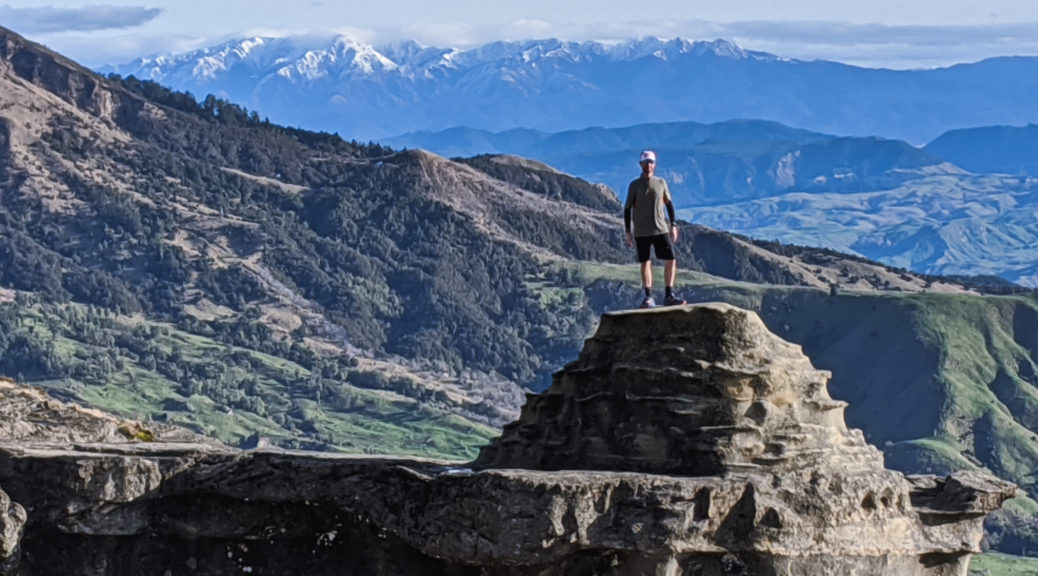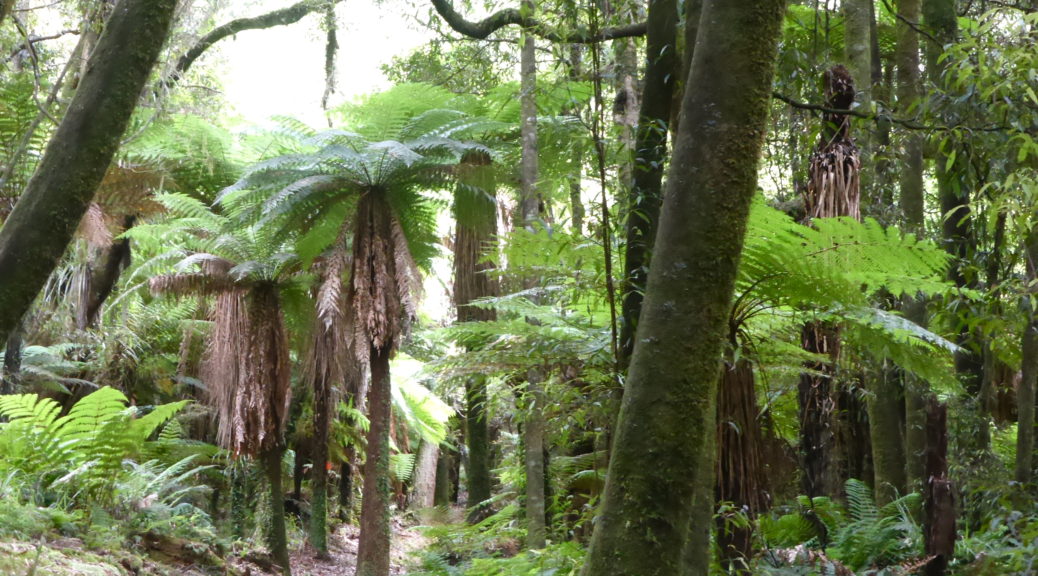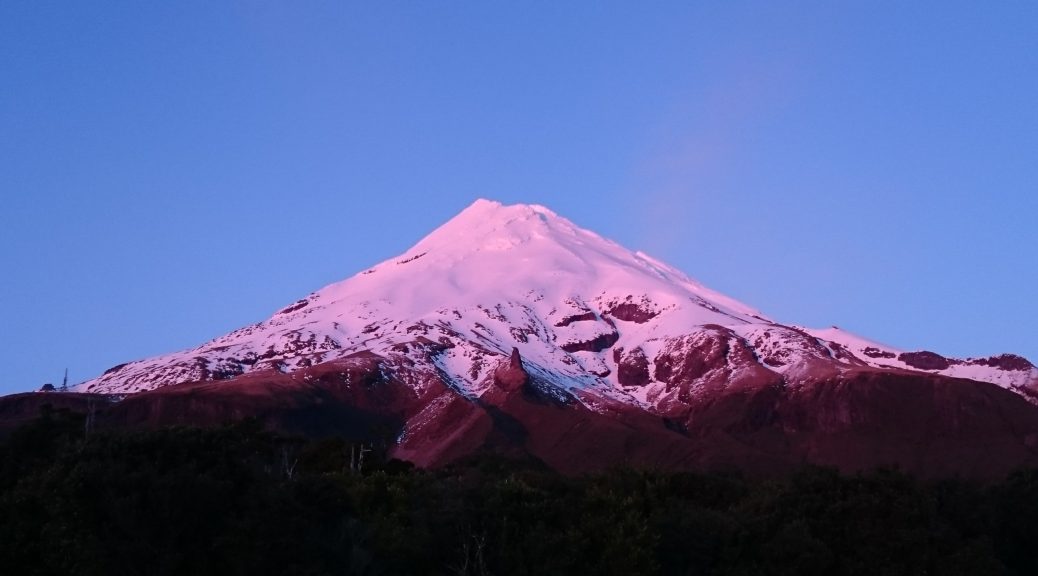With a recent foray into small trail runs, I started looking for a suitable day to finally get up to Bell Rock. It’s notoriously windy up there, the kind of wind where people my size struggle to stand up. Liking to stay near the ground when running, I patiently waited for a clear day (the views are one of the drawcards) with little wind.
After a week of wintry weather, and while the first park run in months tired me out, I was not wasting a glorious Saturday afternoon. Quite a drive later, I was at the trailhead rather counting on that I’d get back before dark. Only three kilometres out, the trail starts with a steep, rooty and slippery section through native bush. I was slow enough not to injure myself, before emerging onto the ridge – the sheltered side it turned out.
 Those hills on the coast became more familiar the following day.
Those hills on the coast became more familiar the following day.
Longer, tussocky grass surrounded and then turned into the route. In the shaded parts of the undulations snow lingered from two days before. That was negotiated slowly, but without incident before a climb over the ridge put me into the wind. I’m glad I chose a stiller day – it was very blowly, and just warm enough to linger without extra layers chatting to a few other daytrippers.
As expected, the views were expansive and I thoroughly enjoyed picking out roads and hills I’d ridden, all the while helping to further piece the jigsaw of Hawke’s Bay together.
 The northern face of the Kawekas, with some rare snow.
The northern face of the Kawekas, with some rare snow.
 North over the Mohaka and stretching towards Whirinaki.
North over the Mohaka and stretching towards Whirinaki.

 Mahia Peninsula in the background, must get back there.
Mahia Peninsula in the background, must get back there.
 Yup, more hills.
Yup, more hills.
Turning, I followed the ridge line all the way back to the road and then that to the car. Fantastic little run, I await a few spare hours and the weather coinciding again.
After liaising with farmers for access across three farms to reach my favourite Hawke’s Bay views for this year’s HBAT, Sunday was the day to scout it out. The first farm was a bit of a long shot, and is not really necessary for the route – but it would add variety. I also suspect I’d be roundly cursed – the other two farms are steep enough, this was another level. Having said that, it was absolutely brilliant – steep climbs on mostly-dry grassed tracks, frequent views of so many Hawke’s Bay landmarks, remote and deserted as far as people went (the stock were numerous, and mystified).
 Partway up the first climb, looking down on the farmhouse; Cape Kidnappers on the horizon.
Partway up the first climb, looking down on the farmhouse; Cape Kidnappers on the horizon.
 My path was level, briefly – but still surrounded by hills.
My path was level, briefly – but still surrounded by hills.
 Welcoming party to another farmhouse, now unused, and with no road access. Private beach is pretty good, but.
Welcoming party to another farmhouse, now unused, and with no road access. Private beach is pretty good, but.
 Fair warning of the start of the next climb.
Fair warning of the start of the next climb.
I missed a track turning left and when I realised, it made more sense to just forge ahead on the track I was on and get back on route. Sure it was hilly, but how hard could eight hundred metres be. I need the hike-a-bike practice after all.
 I found myself atop cliffs earlier than expected.
I found myself atop cliffs earlier than expected.

 They may have been subsiding a little; looking toward Wairoa.
They may have been subsiding a little; looking toward Wairoa.
 That’s the way I was heading, after the summit.
That’s the way I was heading, after the summit.
 Those twelve kilometres only took two hours. Eight hundred metres of climbing, with a fair bit of descent (some of that also hike-a-bike), was a solid start to the day’s loop. Napier just visible in the centre, the three peaks behind Havelock North also just there.
Those twelve kilometres only took two hours. Eight hundred metres of climbing, with a fair bit of descent (some of that also hike-a-bike), was a solid start to the day’s loop. Napier just visible in the centre, the three peaks behind Havelock North also just there.
 One of the reasons I love being up there.
One of the reasons I love being up there.
There starts a screaming descent on a not too-rough, but hardly smooth, farm track. Most enjoyable, especially as everything had dried out after the week’s rain.
 A few more, littler, hills.
A few more, littler, hills.
 Bell Rock is up in the cloud covered hills.
Bell Rock is up in the cloud covered hills.
Out of the farms, that was a fraction of the distance for the day. I only had to continue battling the northerly briefly before turning to have it at my back. After a late lunch at my most-frequented country store, I ambled up Darky’s Spur as shadows lengthened. A single motorbike passed me before I hit the seal, crossed the highway, found the gravel again for some lovely ridge riding before the plunge back to sea level and my car. Gracious hospitality at the first farmhouse had many bike and travel stories shared; they thought I was nuts, but it’s all relative – they’d also seen people biking the Canning Stock Route, that sounds far more nuts to me.


 Perusing maps and brochures, I came up with this vague plan; it happened to be what Steve had in mind too.
Perusing maps and brochures, I came up with this vague plan; it happened to be what Steve had in mind too.
 I got outside in the morning for a hut photo before the rain came in.
I got outside in the morning for a hut photo before the rain came in. Endangered, these ducks are also rare among water birds in that they live year-round on fast flowing rivers.
Endangered, these ducks are also rare among water birds in that they live year-round on fast flowing rivers. Outrageous.
Outrageous. Did I mention there were ferns?
Did I mention there were ferns?

 Quite a spread it was too; hooray for short hiking trips when much fresh food can be carried.
Quite a spread it was too; hooray for short hiking trips when much fresh food can be carried. Finding the orange marker, I contemplated all the crossings to come before wading in. It was luxuriously warm, and like most of the crossings to come – around my knee-height.
Finding the orange marker, I contemplated all the crossings to come before wading in. It was luxuriously warm, and like most of the crossings to come – around my knee-height.
 Oh, there’s the marker. I guess we’re walking up the stream again. A welcome respite from the hook grass.
Oh, there’s the marker. I guess we’re walking up the stream again. A welcome respite from the hook grass. We escaped from the sea of toe-toe!
We escaped from the sea of toe-toe! Once again, our digs for the night were otherwise deserted. (Mangamate Hut)
Once again, our digs for the night were otherwise deserted. (Mangamate Hut) Looking north as the day ends, in much more friendly grass.
Looking north as the day ends, in much more friendly grass. Not a bad spot to devour more of the food we’d hauled in, all in the name of lightening the load for the following day of course.
Not a bad spot to devour more of the food we’d hauled in, all in the name of lightening the load for the following day of course.

 Steve carrying a relatively low inventory.
Steve carrying a relatively low inventory.
 Upper Whirinaki Hut – only subtlety different to the previous night’s hut.
Upper Whirinaki Hut – only subtlety different to the previous night’s hut. The birdlife changed too, wood pigeon (kereru) up here.
The birdlife changed too, wood pigeon (kereru) up here. Disappearing in seas of ferns is preferable to cutty grass.
Disappearing in seas of ferns is preferable to cutty grass. Up on the ridge, we began to get a better impression of the vastness and density of the bush we’d walked through. As well as finding it was a pretty warm day.
Up on the ridge, we began to get a better impression of the vastness and density of the bush we’d walked through. As well as finding it was a pretty warm day. One final pose, near another big tree – there were plenty of those.
One final pose, near another big tree – there were plenty of those.
 The clear skies were also pleasing to see.
The clear skies were also pleasing to see.
 I was taken with the difference and large crown of the cabbage trees – most unusual compared to the ones I usually see.
I was taken with the difference and large crown of the cabbage trees – most unusual compared to the ones I usually see. After a short section of quite narrow snow between rocks and a drop (great introduction), our route opened into a nice wide gully.
After a short section of quite narrow snow between rocks and a drop (great introduction), our route opened into a nice wide gully. Steep enough for this novice.
Steep enough for this novice. Approaching the crater, the ice formations became larger, more unusual and at times surreal.
Approaching the crater, the ice formations became larger, more unusual and at times surreal. In the crater, the surface turned from snow to lumpy, knobby ice.
In the crater, the surface turned from snow to lumpy, knobby ice. It looked rather windswept. While we were still bathed in sun, a layer of cloud encircled the lower reaches of the mountain.
It looked rather windswept. While we were still bathed in sun, a layer of cloud encircled the lower reaches of the mountain.
 Out of the crater, one last pitch up to the summit. Here the ice was in much larger lumps, some of them shattered when bearing weight, others didn’t – they all looked potential ankle breakers though.
Out of the crater, one last pitch up to the summit. Here the ice was in much larger lumps, some of them shattered when bearing weight, others didn’t – they all looked potential ankle breakers though. Five hours after setting off, we had ascended 1500 metres and enjoyed a bit of time on the rather flat and, in this case, calm summit.
Five hours after setting off, we had ascended 1500 metres and enjoyed a bit of time on the rather flat and, in this case, calm summit.
 The weather closed in again, and after two hours of slow descent (oh for skis) I think I was starting to get a bit fatigued. So repetitive…
The weather closed in again, and after two hours of slow descent (oh for skis) I think I was starting to get a bit fatigued. So repetitive… Back on the access track – golly it got steep, no wonder it was paved in part.
Back on the access track – golly it got steep, no wonder it was paved in part. Things cleared a enough to admire a bit more of the scenery.
Things cleared a enough to admire a bit more of the scenery. The sun made a brief appearance in the sky – some of its light even filtered through the canopy.
The sun made a brief appearance in the sky – some of its light even filtered through the canopy.
 The route flattened out a bit as we walked beside and through/over the river for a while.
The route flattened out a bit as we walked beside and through/over the river for a while. While we were still well below the tree line, we started to come across patches of snow – a somewhat worrying sign for walking over the tops.
While we were still well below the tree line, we started to come across patches of snow – a somewhat worrying sign for walking over the tops.
 There’s a pole! Go over there. About half-way up Adele took the lead through the steeper terrain, I had it easy at the back for a while.
There’s a pole! Go over there. About half-way up Adele took the lead through the steeper terrain, I had it easy at the back for a while. Reaching the saddle (we’d climbed about 900 metres in four kilometres – a bit more than I’m used to), we turned to see cloud filling the valley we’d walked up.
Reaching the saddle (we’d climbed about 900 metres in four kilometres – a bit more than I’m used to), we turned to see cloud filling the valley we’d walked up.




